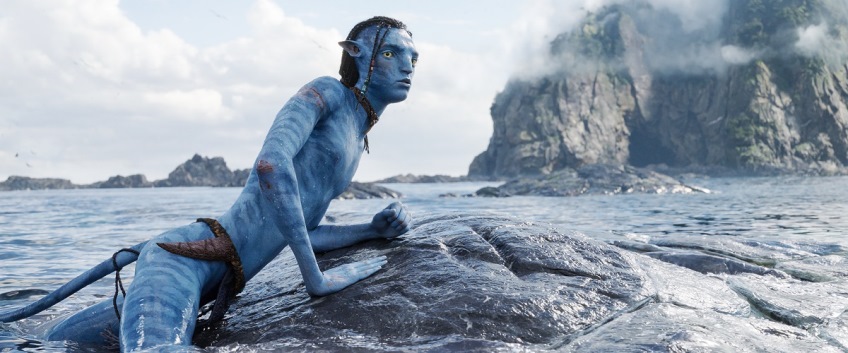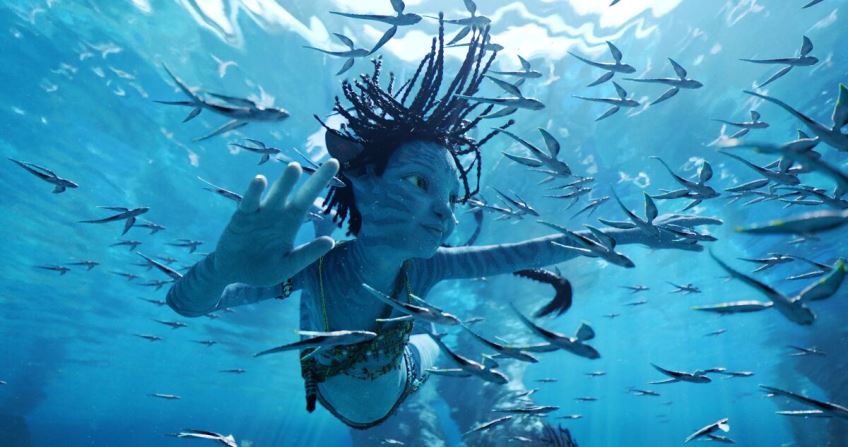Joyce Glasser reviews Avatar: The Way of Water (December 16, 2022) Cert 12A, 192 mins.
While his friend Guillermo del Toro was winning Best Director, Best Picture and Best Production Design Academy Awards for 2017’s The Shape of Water, James Cameron was working on Avatar: The Way of Water, a sequel to his 2009 blockbuster Avatar. Del Toro’s story of a subjugated humanoid amphibian teaching a lonely, mute cleaner how to adapt to a better life under water captured the hearts of Academy Voters with its unsubtle environmental message, its expressionistic production design and romantic love story. Avatar: The Way of Water displays state-of-the-art FX and CGI to create an aquatic fantasy world with an environmental message, but the storytelling and the characters are, remote, flat and uncompelling.
Thirteen years on from Avatar, the Avatar in the title Avatar: The Way of Water is more for identification than plot purposes. Whether there are any more Avatars in the movie at all can be debated. Mining company RDA’s Head of Security Colonel Miles Quaritch (Stephan Lang), the arch-villain of Avatar was killed by Pandora’s Neytiri Tskaha Mo’at’ite (Zoe Saldaña) to stop him murdering her human love-interest Jake Sully (Sam Worthington) or rather, his Avatar. Much to Quaritch’s disgust, Jake no longer needed an Avatar. He went native because of his love for Neytiri and her people’s zero carbon footprint way of life. No wonder: they never eat; they walk around half naked and have no possessions other than bows and arrows.
And since Quaritch is dead, he cannot have an Avatar, can he? Such is the greed and desperation for populating Pandora circa 2170, and such is the need for a story to drive the sequel, that yes, they can! They are called “recombinants.”

Recombinants are Na’vi Avatars implanted with the minds and memories of human soldiers (presumably pre-programmed and stored). Quaritch’s recombinant is the leader of this second mission to the planet of Pandora. The recombinants are, like the population of Pandora, ten-foot-tall blueish creatures, all hairless skin and bone with Margaret Keane-style big eyes, broad, tiger-like noses and endless energy.
Quaritch is a distracted leader, more concerned with killing Jake than populating Pandora with the remnants of dying Earth. And diplomacy is not his strong suit. But he doesn’t bargain on finding his feral human son Spider (Jack Champion) living amongst his foes who had rescued and adopted him. Spider’s split allegiance is a central plot device and designed to inject some emotional drama to the film.
So there is backstory newcomers to the franchise must master before understanding this sequel, and the casting provides other links. Chief among them, Sigourney Weaver voices young Kiri, the daughter of Weaver’s character’s Na’vi Avatar. Head of mission Dr Grace Augustine was a Na’vi sympathiser and her daughter Kiri, was like Spider, adopted by Jake and Neytiri. She senses she is different however and discovers affinities with the watery depths that cause her to seek out her parentage.
When Avatar: the Way of Water opens Jake has been a Na’vi for some 16 years and has two adopted and three biological Na’vi children with Neytiri. Just as the action shifts from the lush, green jungle of the Omaticaya clan to the water world of the reef people, the Metkayina, so the action switches from Jake and Neytiri to their children, although their names are so hard to discern that it is hard to keep track of them. The biological kids are teenager Neteyam (Jamie Flatters), his close brother Lo’ak (Britain Dlaton) and eight-year-old Tuk (Trinity Jo-Li Bliss).

Here’s the plot: The Earth army returns to the jungle where Jake realises he is the target. After Quaritch’s Avatar kidnaps Spider, Jake spares the Omaticaya clan by taking his family to a remote part of the planet where he utters, ‘I just want to keep my family safe’ like The Terminator. Here the refugees are reluctantly welcomed by the Metkayina clan’s leader Tonowari (Cliff Curtis) though less so by his wary, pregnant, tough-as-nails wife Ronal (Kate Winslet, Cameron’s sentimental carry forward from Titanic, although you might not know it’s her until the end credits).
For a good portion of the film we watch Jake and Neytiri and their children adapt to their watery world, learning sign language to speak to the sea creatures, how to ride sea-birds and free diving. Like in Top Gun: Maverick where the actors had to learn to fly combat jets, so the relevant actors here had to learn free diving. The plot stops for this dazzling display from the company Weta FX during which time you might find your mind wandering to I’m a Celebrity or some adventure holiday in the tropics.
When the plot picks up again, Quaritch is torturing the locals for information leading to Jake and, when that fails, hatching a plot to draw Jake out of hiding by killing the sacred sea creatures, including the Tulkin whose brain enzymes are sought after for their precious anti-aging remedies. These brain enzymes are apparently the equivalent of unobtanium, the “unobtainable” mineral humans were after in Avatar.
The script (which could be cut by an hour) is by Cameron and Rick Jaffa and Amanda Silver, the people behind the Planet of the Apes franchise. The plot, though not the set pieces, are predictable and the character interactions and emotions feel mechanical.
The forgettable dialogue is punctuated by weird spiritual passages meant to transport us, like: “The way of war has no beginning and no end; the sea is around you and in you. The sea is your home before you are dead and after you are dead.”
There are no books around so no, Jake is not reading from T.S. Eliot’s The Dry Salvages in the Four Quartets, “The river is within us, the sea is all about us…” There is even a location in Pandora called “Three Brother Rocks” reminiscent of the coastal rock formation called “The Three Savages” that became The Dry Salvages.
We can hope that 72-year-old Russell Paul Carpenter, who won an Oscar for Titanic, will return, but after the jungle and the sea, what ecosystem will Earthlings attempt to destroy in the next instalment?



